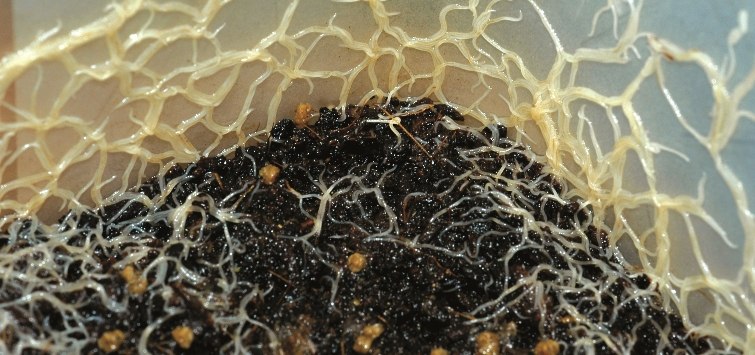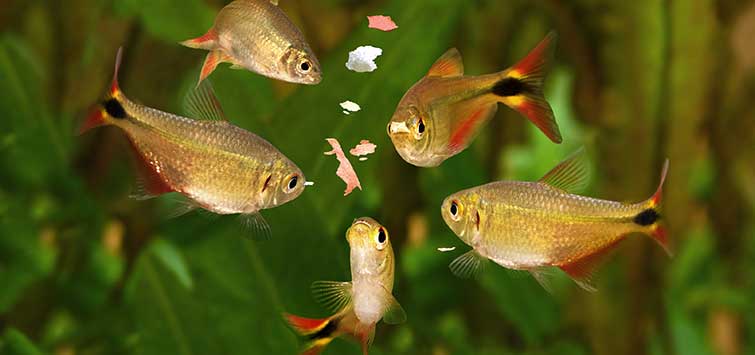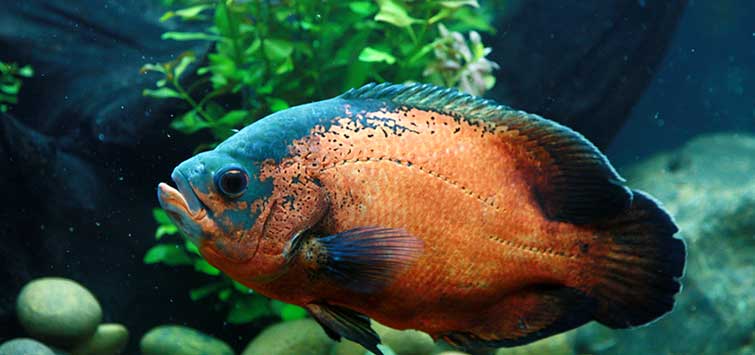Vermiculture: Growing Live Feeder Worms
Author: Peter Jekel
Live foods provide many benefits for aquarium fish. They are generally more nutritious than dried flakes or pellets, as they contain natural proteins, many vitamins, and minerals. And culturing your own live foods can easily provide you with a never-ending supply. Often overlooked by aquarists for this purpose are the various worms, which are an incredibly high-protein, nutritious food suitable for most aquarium fish.
Vermiculture, or worm breeding, can be done not only in a backyard compost pile but also in a room in a house or apartment, or even under a sink in the kitchen. It is probably best to raise your aquarium worms inside, as it will limit the number of insect larvae, microbial pests, and other creatures in your worm farm that could potentially impact your fish.
Vermiculture has many benefits in addition to providing you with worms to feed your fish. It is an efficient tool to convert organic waste like paper into high-quality compost, which is useful if you are also a gardener or a keeper of potted indoor plants.
There are a number of types of worms that can be raised, and each has its own needs. Taking that into consideration as well as the types of fish you have will help you decide which worms to raise. All worm cultures can be started with original stock from a fellow hobbyist, local pet store, or online supplier.
White Worms
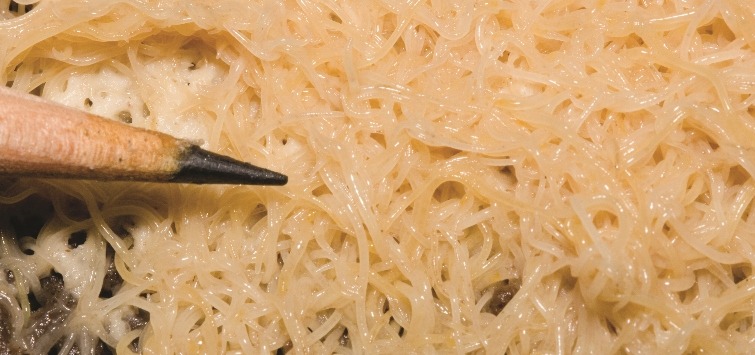
White worms (Enchytraeus albidus) are a great food source made up of at least 70 percent protein, and they are suitable for various aquarium fish. They are annelid worms, related to earthworms, but smaller and white in color. Ranging anywhere from ¾ to 1½ inches (2 to 3.5 cm) in length, they can be fed safely to many small to medium-sized fish.
White worms prefer cool places free of any insects. If you have a small bar fridge, place the container in there and maintain a temperature of around 50° to 65°F (10° to 18°C), somewhat warmer than you would maintain your own food fridge.
Grindal Worms
A close relative of the white worm is the Grindal worm (E. buchholzi). It is somewhat smaller, usually less than half an inch (1 cm) in length, making it ideal for smaller fish feeding. They look a lot like small earthworms and can be found almost anywhere in temperate climates, in places like meadows and roadside ditches.
Grindal worms grow best at temperatures between 70° to 75°F (21° to 24°C), but they can stand temperatures of up to 90°F (32°C). Unlike their relatives the white worms, they cannot tolerate colder temperatures and will start to die off if the temperature of their home drops.
Red Wigglers
Red wigglers (Eisenia fetida) are ideal for any home vermiculture. They also go by a number of names that reflect their use as bait in fishing, such as redworm, panfish worm, and trout worm. Originally from Europe, they have now invaded the entire world with the exception of Antarctica.
They are quite hardy and thrive at temperatures between 55° to 77°F (13° to 25°C) but can survive at temperatures as low as 40°F (4°C) and as high as 100°F (38°C). Red wigglers grow to approximately 4 inches (10 cm) in length, so they are an ideal food for larger fish, such as cichlids and catfishes.
Blackworms
Blackworms (Lumbriculus variegatus) are also annelid worms, and they have been used to feed aquarium fish. Unlike the other feeder worms, however, they are an aquatic species. In the wild, they can normally reach 4 inches (10 cm) in length, but in a hobbyist’s vermiculture setup, half that is more common.
They can be found across Europe and North America in shallow freshwater feeding on microbes and decaying organic material. They are also known as California blackworms and mud worms. Cooler or room temperature water, 68° to 72°F (20° to 22°C), is ideal for blackworm health and growth. Once the temperature exceeds about 80°F (27°C), they will begin to die off.
Microworms
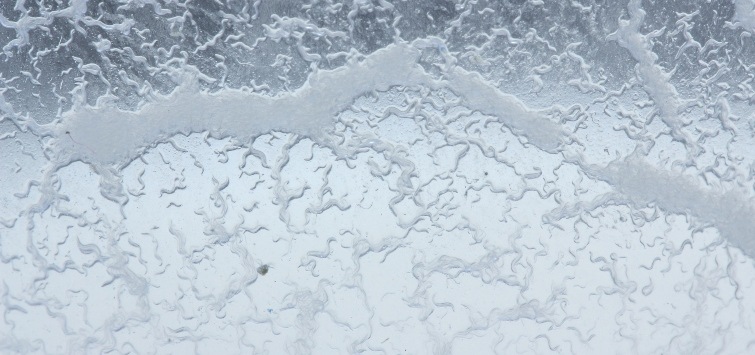
Unlike the other worms described, microworms (Panagrellus redivivus) are ideal food for very small fish, such as fry that have grown too large for an infusoria diet. They are, unlike the other feeder worms, free-living nematode worms. As the name “microworm” implies, they’re very small, reaching only a couple of millimeters.
Microworms prefer cooler temperatures to thrive, living at temperatures just above freezing. Colonies will grow more quickly at higher temperatures, but the cultures seldom last as long. Often the colonies will last up to six months at lower temperatures.
Vermiculture Setup
Start with an opaque or translucent container with a plastic lid. Its size will vary with number of worms that you are looking to harvest. The lid should fit tightly, but drill several holes to allow air exchange. You should also drill holes in the side and bottom to allow for proper drainage. Place it in a shallow tray to allow for the collection of excess water from the culture media. (Note that the excess moisture that may appear in the shallow collection tray is great for any potted plants that you might have.)
Next, add the growth medium. You can fill the container to a depth of about 4 inches (10 cm) with peat moss. It is best to (gently) boil the moss for about an hour to reduce or eliminate any microbes. Let the peat moss cool. Make sure that it is wet but not soaked, then place it in the container.
Another medium that you can use is simple potting soil, but again in order to limit the amount of microbes that could affect the health of the worm colony, it is best to place the potting soil into the oven at 350°F (175°C) for at least 20 minutes. Potting soil, like peat moss, should not be any deeper than 4 inches (10 cm) and should be kept wet, but not soaked.
One other medium that is sometimes used, especially for growing grindal worms, is wet coconut fiber, which can be found at a number of pet stores. The ideal depth for a coconut fiber substrate is the same as for peat or soil. When it comes to aquatic blackworms on the other hand, a medium of soil or peat moss isn’t appropriate; you need shallow water, no more than 5 inches (12.5 cm) deep, with an airstone to supply oxygen. Be sure to change 50 percent of the water daily with fresh water of the same temperature.
If at any time your aquarium worm culture starts to smell off, or there is an infestation of flies or other insects, it is best to discard it and start over. Feeding your fish from an off-smelling culture may be deadly to them, since it might contain bacteria that can kill your fish and just about everything else in the tank.
Better safe than sorry here. Feeding from a worm community containing insect pests is okay, but the lifespan of the worm culture will be shortened once the insect invasion has begun.
Worm Nutrition
The best food for your worms is some organic foodstuffs sprinkled across the medium surface or, in the case of blackworms, onto the water. Oatmeal is often used along with bread crumbs, unsweetened cereals, and slightly wet dog or cat kibble.
Some vegetable and fruit waste can be added, but limit the amount. Never use citrus fruit, as it will create an acidic environment not favored by worms. Another food product to avoid is meat scraps, as not only do most worms not seem to like it, but meat will also acidify the medium as well.
Microworms are an exception, as they do not eat foods offered. Their food of choice is yeast, and to culture the microworms, you must culture yeast in their substrate. Add a high-starch food like bread or oatmeal to their culture, along with a very small pinch of yeast. Keep the substrate moist and the yeast will slowly eat it, reproducing and feeding the microworms. A good, healthy microworm culture has a slight smell of fermentation, like beer. The yeast is producing alcohol, and too much will kill the culture. If the smell gets too strong, scrape some of the worms off and start a new culture.
The key to feeding any of the feeder worms is to give them just enough so they consume it within three days. This will take some practice. The amount will also vary as the population of worms increases or decreases. If you have a tendency to overfeed, the decay of the food material will raise the temperature of the worm culture to levels that may result in a worm die-off. If any of the food starts to mold over, discard it immediately.
When it comes to the red wigglers specifically, they can be fed shredded newspaper torn into thin strips. Moisten the newspaper shreds, preferably with a spray bottle so you can prevent it from becoming too wet or soggy. The newspaper shreds can serve as the red wigglers’ only food source, but worms fed this way will remain relatively small. If you add the occasional plant-based kitchen waste, your red wigglers will grow more quickly and reach larger sizes.
Harvesting Your Worm Culture
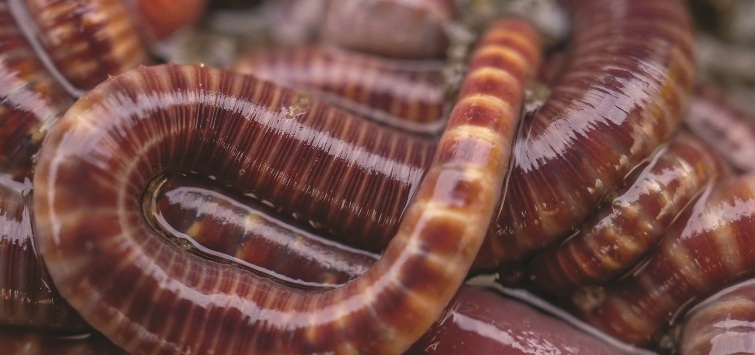
Normally, you will have worms ready for harvest around one to three months. If, though, you see the worms starting to crawl up the sides sooner, it is time to either harvest or start another culture. Worms removed from the sides of the container are usually cleaner than those in the substrate. However, with respect to blackworms, if they are starting to crawl out of their home, they need fresh water immediately.
You can also place a plastic sheet in an area of the culture medium and sprinkle it with food; the worms will crawl aboard and start feeding within a day or so. All worms should be rinsed off before feeding them to your fish.
Microworms require a slightly different harvesting protocol. Instead of feeding them with food on the surface, it is best to heat up the container holding the worms. Something as simple as placing the container on the lighting unit of an aquarium will work. With the addition of heat, the microworms will venture to the sides of the container, at which time they can be removed and added to the tank. Again, by removing them from the sides, you will limit the amount of culture media that might be picked up.
There are times that a worm community can unexpectedly crash, so having a backup community in another container means that you will never run out of nutritious fish food.
High-Protein Fish Treats
Aquarium worms are a great and easy way to feed your fish a high-protein snack. They are clean and ecologically sound to keep, as they are a fantastic way to get rid of food waste and, in the case of red wigglers, old newspapers.A word of caution, though, is that worms, in addition to being high-protein foods, are also high in fat. Overfeeding your fish with worms will result in fat or overweight fish, which, in turn, will result in a number of other health problems for your aquatic pets.

.png?h=595&iar=0&w=2781&hash=5FD5E69473BCC22199FBFA2FB71B6033)
